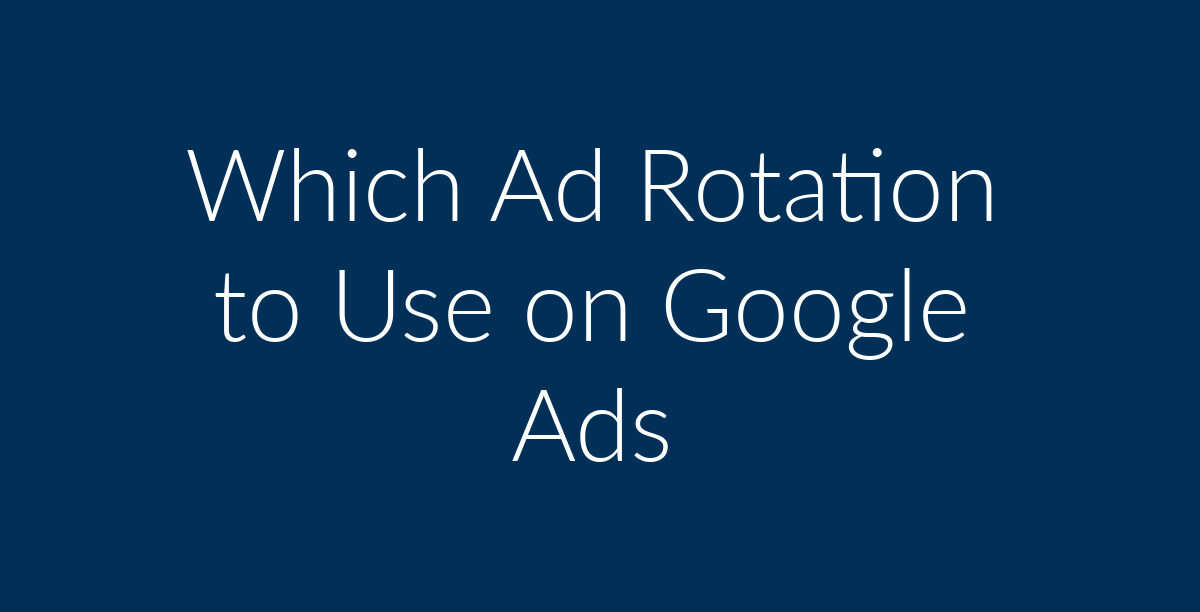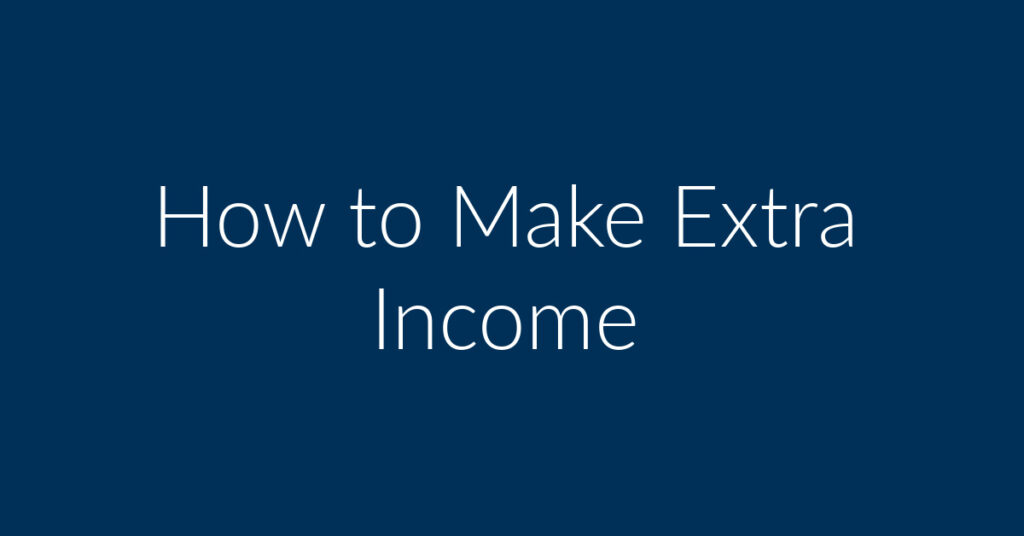Advertising on Google is a must for businesses that wish to survive in today’s ultra-competitive marketplace. But most people get confused when it comes to choosing the best ad rotation strategy. That’s where I come in. Hi, my name is Francisco. I own a Digital Marketing company called Planet Marketing. We specialize in Google Ads, Facebook Ads, and remarketing. In this article, I will show you the best ad rotation to use on Google Ads. The article is composed of the following areas;
- What are Ad Groups in Google Ads?
- What is ad rotation?
- Ad rotation options.
- Best ad rotation to use on Google Ads.
What are Ad Groups in Google Ads?
Before we get into defining Ad rotation in Google Ads, we first need to talk about Ad Groups. Each Ad that you create on Google is targeted at a particular audience. This applies whether we are talking about the display network or the search network.
One thing that will happen as time goes on is that you will have a lot of different ads. Many of these will have the same target audiences and products.
To avoid clutter, it’s better to organize ads into Ad Groups. An ad group can have one or more ads. These ads have certain things in common. As an example, we have already noted that they could be sharing the same audience or the same products.
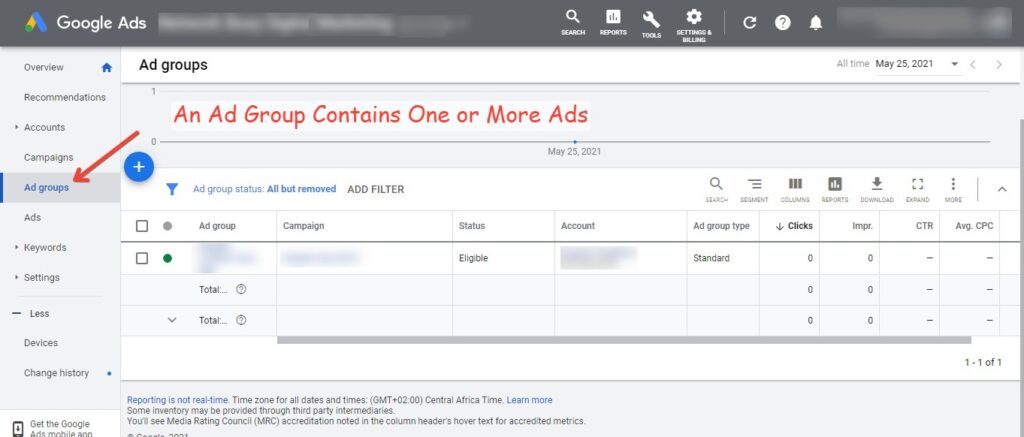
What are ad groups in Google Ads
Ad groups are important for organizing your ads. Ad groups usually roughly correspond to the categories on your website. Let’s say you own a freight company. You will probably have lowbed, flatbed and triaxle trucks in your stable. These would then become ad groups for your Google Ads. You can see what I am talking about in the table below.
| Lowbeds | Flatbeds | Triaxel |
|---|---|---|
| 20% off offer | Container shipping | 30 tons |
| 30 ton | minerals transportation | Abnormal Loads |
| Free quote | 34 tones | Affordable |
| Florida to New York | Reliable Service | New York To Florida |
The ad groups above would roughly correspond to the sections on a freight company’s website. Under each section, there are possible ads.
As an example, you could have an ad covering container shipping. Under the same Flatbet category, or ad group, you would also have another ad marketing the company’s minerals transportation service.
The whole idea is to have sanity in the management of your ads. That’s particularly useful if you are an agency. Over time, you are going to have hundreds of clients. Having Campaigns and Ad Groups helps you keep track of of what’s happening.
As an example, if I want to see how my ads for Flatbed trucks have been doing, I would simply go to the Flatbeds Ad group.
You can set a CPC bid for an entire ad group
When it comes to spending limits on your ad, you have the option to set a bid relating to an ad group. Maybe you have set $1.20 as your bid for the SEO ad group in our example.
What this means is that each of the ads in the group will share the same spending limit. If you have 10 ads within the same group, they will all have a bid maximum of $1.20.
You can individually set CPC bids for each ad in an ad group
It’s also possible for you to set CPC bids for each of the keywords in an ad group. That means you could end up having the rank tracking keyword having a CPC price of $1.10, and the link building keyword given a CPC bid of $2.00
To summarize this section, Ad Groups are composed of related ads. Instead of having each standing on its own, which can lead to clutter; its way better to group ads based on similarities. But how and why is this relevant when it comes to Ad rotation on Google Ads?
What is Ad Rotation?
Google advises that it’s better to have a minimum of 3 ads in each ad group. That’s useful for the purposes on optimization. But what happens if you have 5, 6 or 7 ads covering the same keyword? How does Google determine which to show at any particular point in time? This is where ad rotation comes into play.
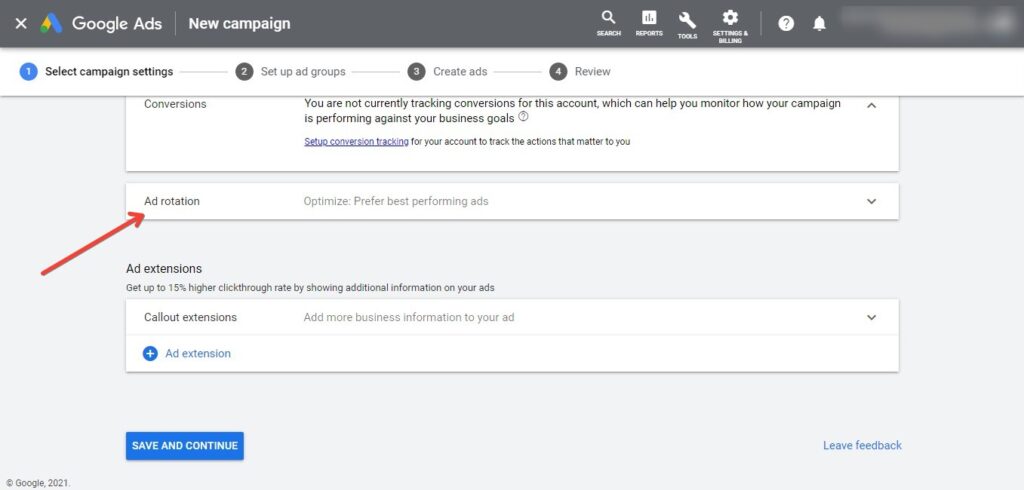
Ad Rotation
Simply put, ad rotation is the way in which Google decides the sequence in which the ads in an ad group will appear when triggered by a relevant keyword. That’s important because no 2 ads from the same group can appear at the same time. So, there is need to decide on the sequence of their appearance.
Ad rotation options
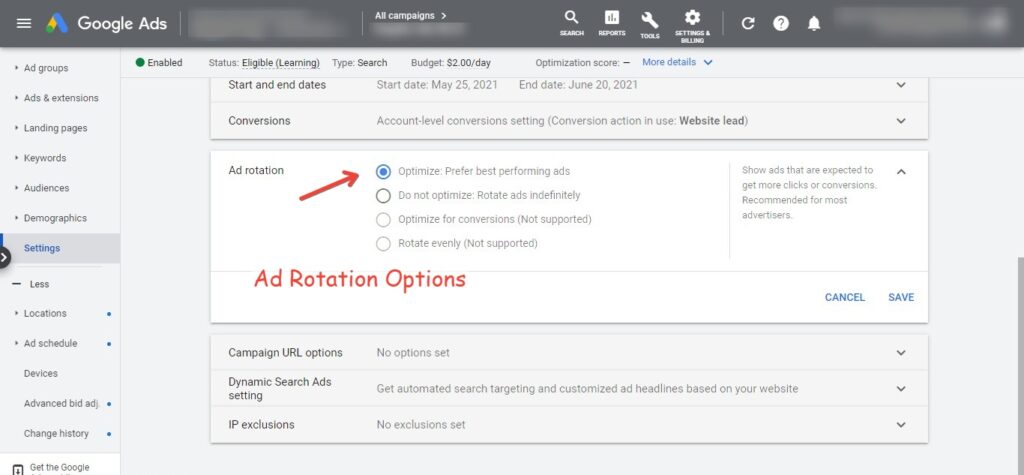
Ad Rotation Options in Google Ads
In Google Ads, you have 4 options when it comes to ad rotation. Note that some of these options will not be available all the time. It depends on how your Campaign is being set up. Here, we will look at the Optimize and Do not optimize: Rotate ads indefinitely options;
1. Optimize: Prefer best performing ads
First, you have the Optimize option. Should you choose this option, Google will use machine learning to determine which ad in an ad group will likely perform best for a given keyword, search term, device, location, among other signals.
Google learns from the data that it accumulates as your ads are running. As time goes on, the system will begin to favor ads that have been performing better. That’s based on clicks and conversions. These ads are then shown more than the other ads in the same ad group.
Advantages of an Optimize strategy
Allowing Google to prioritize better performing ads comes with a number of advantages. For one thing, it means you could end up getting a lot more ROI because you will be getting that many more clicks.
Remember, Google prioritizes better performing ads in terms of CTR. Ads getting more clicks are shown more than those that have been performing at a lower rate.
2. Rotate ads indefinitely
This is the second option when it comes to ads rotation for Google ads. If you go for this option, what it means is that ads in the same ad group will be evenly rotated when triggered by relevant keywords.
It doesn’t matter whether some ads within the group are better performing than ads. The frequency at which ads will be shown will about be even.
Advantages of a rotate ads indefinitely strategy
You may have thought that the optimize strategy is better when it comes to Google Ads. But you would be solely mistaken.
Thing is, a rotate ads indefinitely strategy comes with a number of major advantages. The biggest of these is that you get useful data on which of your ads is performing best at any given point in time. But what do we mean here?
Remember that you cannot have both optimize and rotate settings running at the same time. You need to choose one setting. What then happens with the optimize option is that you are never that clear which of your ads are performing best. Performance is measured based on the number of clicks that you will be getting.
While that is great, it’s not actually an accurate measure of performance. What matters most at the end of the day are clicks. And the challenge with the optimize option is that you could end up with Google favoring ads that have more clicks but that are having dismal performances in terms of conversions.
That’s the information that you get when you choose a rotate strategy. You get a lot of comparative data that you can analyze to determine which of your ads performing better where it matters the most, in terms of conversions.
NB: Ad Rank is important
I thought I should take this opportunity to mention that performance for ads under the Rotate ads indefinitely setting can still be different. That’s because there are many factors determining when and where your ads are going to be shown. These factors include Ad Rank.
Each ad in Google Ads is given a rank. This determines where it will be shown in relation to competing ads. Ad rank is determined by a number of factors;
- The bid amount.
- Ad quality (CTR, relevance and landing page).
- Competitiveness for the target keyword.
- Search context (eg location, time, device).
- Expected impact of extensions.
Why is this relevant?
So, why is Ad Rank relevant to the issue of Ad Rotation in Google Ads? Well, we have already noted that your ads could end up performing differently, even when you have chosen Rotate ads indefinitely as your setting.
Ad rank determines where your ad will appear. So, even though you could have an even rotation, higher quality ads (those with a better rank) will perform better. They will appear on the first page, where they are much more likely to get clicks. Meanwhile, lower performing ads will appear on other pages, if at all.
Which Ad Rotation to Use on Google Ads
So, which option should you go for, between rotate and optimize? This tends to be a dilemma for most PPC consultants. Google itself advises that an optimize strategy is better. But is that true? Personally, I would advise that people go for this strategy.
That’s particularly the case for beginners. It you have just started advertising on Google, there is no need to you to crack your head trying to decide which ad should be given priority in each ad group. It’s better to let Google do the hard work on your behalf.
Ad rotation gives you control
However, I have come across some PPC consultants who argue that a rotate strategy is better, because it allows you to gather a lot of information regarding the true performance of your ads. The issue here is about control. Most professionals will go for this option because it gives them control over the handling of their ads.
If you choose to rate your ads indefinitely, it means you can go in there to see which ad is performing best. You can also pause low performance ads. So, this is an important strategy. You get a wealth of information, allowing you to make decisions that would have been impossible with an optimize strategy.
Rotate indefinitely is better if you are adding new ads
A rotate indefinitely strategy is also the best option if you are adding new ads to your ad group. What usually happens is that Google will ignore these new ads should you go for an optimize strategy.
It will look at your data, and it will determine that there are already ads in the group that have been performing better than the new ad. So, your new ad risks being ignored, which is not what you will be looking for.
In that case, you will be better placed allowing your ads to rotate evenly, meaning the new ad will be shown as much as the old ads. That way, you can be better placed to see whether or not it will be performing better.
You get better overall performance with an optimize strategy
As you can see, the issue presents something of a dilemma. What you are looking for at the end of the day is better performance. And that’s quantified in terms of the click through rate that you will be getting. Naturally, more clicks should translate into more conversions.
Should that not turn out to be the case, then you would need to take a real look at other performance impacting factors. Perhaps your landing page is not optimized best, leading to the loss of much sought after leads? In that case, you would need to work on the landing page.
How to change your ad rotation strategy
Now that you have decided on which ad rotation strategy to use in Google Ads, it’s time for us to show you how to go about making changes. The following is how to set ad rotation for a Campaign;
- Sign into Google Ads.
- In your Dashboard, click on Campaigns and open the Campaign whose rotation your wish to set.
- Click on the Settings tab.
- Scroll down to Additional Settings.
- Go to Ad rotation.
- Choose your preferred ad rotation setting.
- Save your changes.
Summary
In this article, I showed you which ad rotation to use on Google Ads. I noted that you have two main options. First, you can allow Google to optimize things on your behalf. That way, better performing ads in each ad group will be given priority. Next, you can choose to rotate your ads indefinitely. That way, ads will be shown more or less evenly.
I noted in the later part of this article that the strategy that you choose depends on your particular situation. Most professionals prefer the rotate strategy. That’s because they have more time to check through the metrics in their accounts, allowing them to make informed decisions about which ads to prioritize and which to discard.
However, if you are not a professional, you may wish to go with an optimize strategy. That way, Google will make the correct decisions on your behalf, allowing your ads to perform better overall. Google gives priority to better performing ads under this scheme.
Finally, I noted that I personally would recommend an optimize strategy. That’s the option that’s recommended by Google. And let’s face it, 90% of us are not professionals. It’s way better to allow the Google AIs to decide the rotation strategy that leads to better overall performance for our ads.

